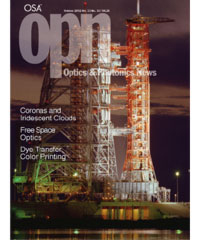
October 2002 Issue
Feature Articles
The Dye Transfer Color Print Process
For half of the 20th century, people who wanted the very best color prints, and for whom price was no object, demanded dye transfer prints. By the dawn of the new millennium, however, dye transfer printing had largely vanished from the scene. A professional photographer explains why the dye transfer process dominated the field of quality printing for so many years and describes how a range of economic and technological factors ultimately led to its decline.
by CteinCoronas and Iridescent Clouds
Coronas and iridescence occur when light is diffracted by small particles of liquid water or ice in the atmosphere. Diffraction colors are particularly vivid in mountain wave clouds because of the small particles and narrow particle-size distributions. The photographs shown here provide evidence that wave cloud diffraction displays are often created by unusually tiny, quasi-spherical ice particles.
by Joseph A. Shaw and Paul J. NeimanFree Space Optics for Laser Communication Through the Air
Free space optics (FSO) communication involves the use of modulated optical or laser beams to send telecommunication information through the atmosphere. The concept of FSO light communication is not new: in his photophone patent of 1880, Alexander Graham Bell demonstrated use of an intensity-modulated optical beam (sunlight) to transmit telephone signals 200 m through the air to a distant receiver.
by Dennis KillingerOptics and Information Technology
How optical scientists work and what they can make has changed profoundly with the information technology revolution of the past 50 years. The software packages developed to aid in the traditional activities of lens and coating design are now several generations old. New programs capable of tackling increasingly sophisticated optical problems are emerging: examples include optimization packages for non-imaging optics in illumination and programs to model the complex physics of multichannel, multiwavelength, fiber-optic telecommunications systems.
by Michael WenyonDepartments and Columns
Photonics Training Program Gathers Steam
Despite the shortage of photonics technicians, only two New England community colleges were offering photonics technology degrees at the associate level in August 2000, the year the New England Board of Higher Education received funding from the National Science Foundation (NSF) for a program aimed at increasing the number of schools offering photonics training. Given the rapid growth of the local photonics industry and the shortage of qualified workers, the NSF grant, made under the auspices of the Advanced Technology Education program, was particularly timely.
WinEdt: A Visual Interface for TeX and LaTeX
In this article we discuss WinEdt, a shareware program for Microsoft Windows that provides a graphical (point and click) user interface for applications such as MiKTeX, a popular TeX freeware package. WinEdt is an editor and shell for MS Windows that can facilitate the creation of TeX/LaTeX documents.
Experiments With 3D Displays
OPN presents the second in a series of hands-on experiments developed by OSA Fellow Keigo Iizuka to spark interest in optics among members of the general public.
Optical Science Central to Homeland Defense
The containment of terrorism demands the same intensive, long-term, government-supported scientific effort that produced the atomic bomb, landed men on the moon, and helped win the Cold War. The fact that optical science will be an essential contributor to the endeavor is the explicit message of a National Research Council (NRC) report issued over the course of the summer.
Robert Andrews Millikan: A Life Devoted to Physics
This is the second in a series of articles highlighting outstanding personalities in the history of optical science. The physicist Robert Andrews Millikan (1868-1953) is one of 23 OSA members to have been honored with the Nobel Prize.

![Infinity Mirrored Room– Brilliance of the Souls 2014 by artist Yayoi Kusama. [© YAYOI KUSAMA]](https://opnmedia.blob.core.windows.net/$web/opn/media/images/articles/2024/0724/departments/202407-cover-web.jpg?ext=.jpg)
![An experimental scheme demonstrated by researchers at Princeton and Yale universities, USA, can convert physical noise into errors that can be corrected more easily. [F. Wojciechowski, Princeton University]](https://opnmedia.blob.core.windows.net/$web/opn/media/images/articles/2024/0624/departments/202406-cover-web.jpg?ext=.jpg)
